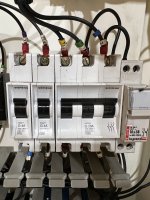markz528
Hot Rolled
- Joined
- Sep 25, 2012
- Location
- Cincinnati
Just reread the original question - will other components be ok?
I would think you would be ok. Because you are not just changing the voltage - you are also increasing the frequency so the volts/hz stays the same (see my motor comments). When the frequency goes up the impedance goes up so the current should be the same because volts/hz is the same. There might be some additional heating, but I personally don't think it would be a problem.
But I have not personally done it so can't say 100%.
I would think you would be ok. Because you are not just changing the voltage - you are also increasing the frequency so the volts/hz stays the same (see my motor comments). When the frequency goes up the impedance goes up so the current should be the same because volts/hz is the same. There might be some additional heating, but I personally don't think it would be a problem.
But I have not personally done it so can't say 100%.




